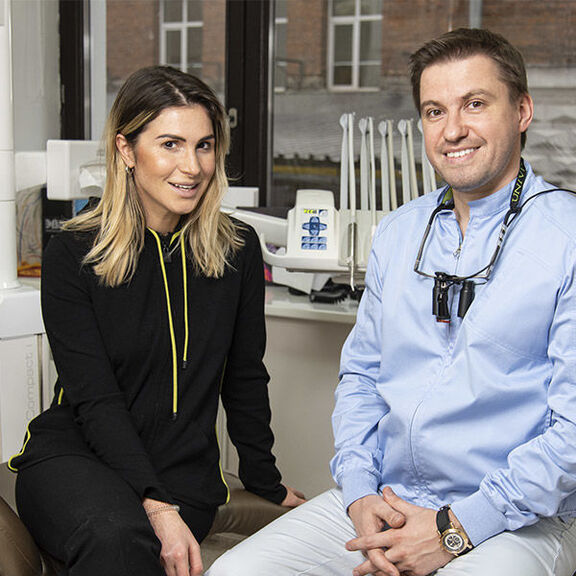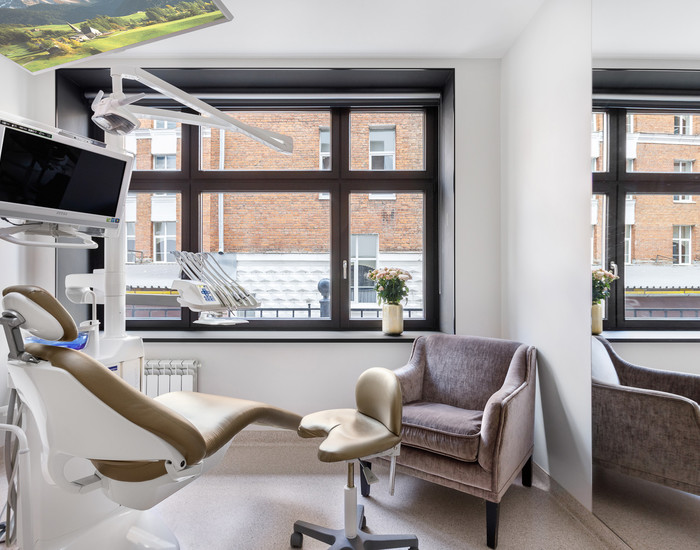Gum recession is the reduction in gum tissue volume, during which the edge of the gum lowers, exposing the roots and necks of the teeth. Initially, this may not cause concern, but over time the situation will worsen. The issue is not only aesthetic. Tooth roots are not covered by a protective enamel layer, thus significantly increasing the likelihood of caries and other diseases. AESTHETE dental clinic provides assistance in treating gum recession. Experienced doctors successfully address complex problems.
How we can be
useful to you:
Veneers Without Grinding
Pediatric dentistry
Correction of bite
Implantation and crowns
Causes of Recession
There are several reasons why gum tissue volume decreases. Periodontitis – an inflammatory process that affects the ligament apparatus surrounding the tooth, most often occurs due to improper or insufficient oral hygiene. Additional negative factors include smoking, alcohol consumption, diabetes, and other chronic diseases. Injuries caused by improper tooth brushing.
It is possible to damage the gum with too hard a brush, brushing teeth for 5 minutes or more, frequently using toothpicks, cleaning the interdental spaces with a pencil. Prominently expressed frenula and cords, connective tissue formations of the mucosa, can also be a source of the problem.
The gum experiences increased tension in the area of their occurrence. Incorrect occlusion: the roots of the teeth that are in the wrong position are exposed because the bone tissue around them is very thin. A similar problem may arise during orthodontic treatment when teeth are actively moved and the bone next to them thins. Other causes that lead to gum recession include:
- accumulation of soft plaque, formation of hard deposits leading to inflammation;
- mechanical damage due to harmful habits – for example, if a person often chews the tip of a pencil or pen;
- errors during implant or denture placement;
- age-related changes in the body – recession often occurs in elderly people.
Symptoms and Consequences
A characteristic sign of recession is a change in the level of the gingival margin, where teeth visually lengthen as their necks and roots become visible. Usually, the problem initially affects one or several teeth. If not addressed, the volume of soft tissue gradually decreases over a larger area or even across the entire dental row.
At the same time, sensitivity to cold and hot, sour or sweet typically increases.
In some cases, gaps may occur between the teeth in the root zone. Food particles get stuck in them, and bacterial plaque accumulates. This increases the risk of caries.
If left untreated for a long time, possible complications include:
- bleeding and inflammation of the gums;
- formation of periodontal pockets, where food particles, bacterial plaque, and in advanced cases – pus accumulate;
- mobility of teeth.
Gum Recession Treatment
-
Title
Price
-
Gum Recession Treatment
from 1 670 AED
Classification of Recessions
There are several types of the disease. It is necessary for the dentist to accurately classify the specific clinical case to determine the treatment approach.
Based on the cause of occurrence, they distinguish inflammatory, traumatic, orthodontic recession. Another possible classification:
- traumatic type – typical for patients under 30 years old, often observed on the anterior surface of teeth, rarely accompanied by inflammation;
- symptomatic – develops at any age on the frontal or internal surface of teeth due to improper or insufficient oral hygiene, in some cases extends to the interdental gingival space;
- physiological – usually occurs in elderly patients due to aging of the periodontal tissues, inflammation occurs rarely.
Another classification is by the severity of the problem. They distinguish three forms, which are:
- mild – the gingival margin is lowered by no more than 3 mm;
- moderate;
- severe – the gingival margin is lowered by 5 mm or more.
Open recession can be determined visually, during examination. Closed type requires probing.
They also differentiate between localized and generalized recession. In the first case, it affects a limited area, in the second, it spreads across the entire oral cavity.
Indications for Recession Treatment
A patient may seek medical help themselves to solve the problem, often for aesthetic reasons: during a conversation or when a person smiles, the lowered gum and exposed tooth roots look unattractive.
In other cases, the doctor recommends treatment:
- due to increased tooth sensitivity;
- in connection with a high probability of caries development;
- because the recession is progressing, the gingival margin continues to lower.
- Eliminating the problem may be required as one of the steps in preparation for implant placement or removable dentures.
More Dental Services
Treatment Methods
Treatment of recession is carried out after diagnosis. It includes examination, X-ray, computed tomography, laboratory tests.
Also, preparation is necessary before eliminating the recession. It will require sanitation of the oral cavity, professional teeth cleaning.
Features of the Surgical Method
If there is significant tissue loss, surgery will be necessary, there are no other methods to solve the problem. The method of surgical intervention is chosen according to the clinical situation.
A common option is the application of a flap. It is used for minor recession, for example, caused by mechanical trauma. If there is a wound, it is washed and sutured. Then the doctor uses a fragment of nearby tissues to cover the exposed necks and roots of the teeth.
In more complex cases, they use graft transplantation – tissue taken from the palate or another part of the patient's gum.
Surgeons also use the tunneling technique, which is effective in localized or generalized recession. The doctor:
- cuts the edge of the gum;
- creates a tunnel under the mucous membrane;
- places the graft in the created cavity;
- sutures the placed tissue just above the tooth neck.
In complex situations, the operation is performed in two stages. First, the doctor installs the graft and waits for it to heal, which takes 1-2 months, after which the tissue flap is moved to the required level.
Non-Surgical Treatment Methods
Solving the problem without surgical intervention is possible only if the recession is at an early stage and the lowering of the gingival margin is minimal. Also, the result of using non-surgical methods depends on the cause of the tissue loss.
Doctors use:
- biogels with hyaluronic acid;
- collagen injections – this helps with mild recession caused by an inflammatory process;
- membranes that stimulate tissue regeneration: they can be removable, non-removable, self-absorbing.
Possible Complications
Complications after surgical treatment of gum recession occur rarely. In some cases, the following complications may occur.
Pronounced swelling – normally, swelling goes away on its own within a few days, but if the overall well-being is satisfactory and the swelling does not disappear, cold can be applied.
Bleeding – a pink coloration of saliva in the first days after surgery is normal. Damage to a vessel or traumatization of the wound may cause more intense bleeding. Cold can be applied; if the blood continues to flow, it is necessary to see a doctor.
Formation of a hematoma due to blood accumulation. This may hinder the healing of the flap, so a doctor's help will be required.
Hyperesthesia (increased tooth sensitivity) – in this case, enamel remineralization will help, you can use toothpastes and rinses prescribed by a doctor.
Mobility of teeth – the problem can be solved with temporary splinting.
The risk of complications will be lower if the doctor's recommendations are strictly followed. It is necessary to:
- use only antibacterial and anti-inflammatory solutions for oral care at first, after 3 days you can brush your teeth with a soft brush, avoiding the operated area;
- refrain from hot and cold food for a few days, do not eat sour, spicy, salty, consume soft foods;
- avoid sports;
- not visit a sauna or a bathhouse;
- come at the appointed time for a follow-up examination with the dentist.
To make you healthy,
happy and successful!
will help you with this
Prevention
The risk of developing this disease can be reduced. To do this, you need to:
- timely treat caries, other dental and gum diseases;
- avoid injuring the gums, ensure that they do not bleed;
- regularly and properly care for the oral cavity, not use too hard a brush, carefully use toothpicks;
- quit harmful habits – do not smoke, do not consume alcohol, do not chew a pen or pencil;
- visit a dentist for a preventive examination at least once every 6 months – they will detect signs of the disease before the symptoms become clearly expressed.
AESTHETE dental clinic is located in Dubai (UAE), Bluewaters Island. We employ doctors who successfully eliminate gum recession. We welcome patients of all ages, working with children and the elderly. Solid practical experience, high qualification of dentists allow accurate diagnosis, selection of an appropriate treatment method according to the clinical situation.
Book an appointment! If you have questions, clinic managers will answer them.
Evaluate the amazing
results of our clients:
FAQ
To prevent gum tissue recession, it is necessary to:
- Visit the dentist for a check-up every six months;
- Brush your teeth daily using a toothbrush with soft or medium bristles that do not injure the gums;
- Use dental floss, doing it carefully to avoid damaging the soft tissues;
- Avoid alcohol and do not smoke;
- Have dental plaque and tartar removed by a dental hygienist at least once a year;
- Lead a healthy lifestyle;
- Follow proper nutrition principles and avoid foods harmful to the gums – excessively spicy, acidic, or hard foods.
Gum grafting has the following benefits:
- Restores gum health;
- Prevents bone loss;
- Reduces the risk of gum diseases;
- Decreases the likelihood of tooth decay;
- Improves the aesthetics of the smile;
- Eliminates increased tooth sensitivity.
Full healing after gum grafting can take from 2–3 weeks to several months. The stages of recovery are as follows:
- 2 weeks – the edges of the graft fuse and epithelialize (a gentle diet with careful chewing and careful brushing with a soft toothbrush is required);
- 1 month – new blood vessels grow (using a medium-bristle toothbrush may be allowed);
- 3 months – normal gum contour is restored (flossing is permissible);
- 6 months – complete integration of the graft, and removal of any prior restrictions.
Literature sources
- Adilkhanyan VA. Soft tissue management as the part of the combined method of aesthetic rehabilitation of the patient. The Dental Institute. 2011;(2):35–37.
- Aguilar-Duran L, Mir-Mari J, Figueiredo R, Valmaseda-Castellón E. Is measurement of the gingival biotype reliable? Agreement among different assessment methods. Med Oral Patol Oral Cir Bucal. 2020;25(1):e144–e149
- Pini Prato G. Mucogingival deformities. Ann Periodontol. 1999;4:98–101.
- Kassab MM, Cohen RE. The etiology and prevalence of gingival recession. J Am Dent Assoc. 2003;134:220–225.
Our clinics:
Clinic in Dubai
Resident part, Building 10
Clinic in Moscow
metro Chistye prudy
Clinic in Moscow (Barvikha)
Shopping center "Dream House" 3rd floor
















































_700x550_ac7.jpg)






